#japanese adzuki bean dessert recipes
Text
Sweet Cooked Azuki Beans 400g from Seelan Market

#azuki beans recipe#how to cook adzuki beans sweet#how to cook red bean#japanese adzuki bean dessert recipes#sweet beans asian#Sweet Cooked Azuki Beans 400g#sweet red
1 note
·
View note
Text

Vegan Taiyaki
226 notes
·
View notes
Text
Our 12 Favourite Waffles

Waffles are one of our most popular dessert offerings. We started with Belgian waffles, then added waffles on a stick. Perfect as a walk around whilst you eat kinda food. Currently we are starting a roadshow for a major financial company, with visits to some 20 universities around the UK offering waffles on a stick.
But it got me thinking, what do waffles around the world look like. So here is a quick look at some of the weird and wonderful options from around the world.
Belgian Waffles
Belgian Waffles Carts For Hire
Probably the best known of the waffles. Introduced at the 1958 Expo in Brussels. They were introduced into America in 1962 by Belgian Walter Cleyman and served with strawberries and cream. Still a popular option today.
They were based on a simplified recipe for the Brussels waffle, legend has it that the name in the States was changed to the Bel-Gem due to the average American being unable to identify Brussels as being in Belgium.
Bergische
Bergische Waffles
A specialty of the German region of Bergische, these are heart shaped and served with cherries, cream and rice pudding as part of the traditional Sunday's dinner in the region. Less dense and crispier than their Belgian counterparts.
Pandan Waffles
Pandan Waffles
Or 'Green Vietnamese Waffles', a popular street food in Vietnam. The Pandan flavouring and coconut milk in the batter give it the distinctive green appearance. Unlike most waffles elsewhere these are typically eaten plain.
Gofri Waffles
Gofri Waffles
Next up is Italy's entry. Or to be more precise the Piedmont region. Containing no egg or milk they are lighter and crispier in texture than other variants.
Moffles
Dddeco - Own work CC BY-SA 3.0
This one is something different, by the Japanese (Who else). a Mochi rice cake cooked in a waffle iron. A crispy exterior with a glutinous mochi insides. Served both as a dessert with condiments, or as a savoury offering with ham, cheese or cod roe.
Stroopwafels
Stroopwafels Takeaway - Own work CC BY-SA 3.0
From one of our favourite countries (The Netherlands) comes the stroopwafel. Originally from the Dutch city of Gouda. Made from flour, butter, brown sugar, yeast, milk, and eggs. Balls of batter are placed on an iron, whilst it is still warm, it is cut in half, and the filling spread over the surfaces gluing them together.
Taiyaki
Taiyaki By Ocdp - Own work, CC0,
A Japanese entry dating from 1909, this is shaped like a Sea bream fish, and commonly sold as a street food. The most common filling is red bean paste that is made from sweetened adzuki beans. Though Custard, chocolate and cheese are also offered.
Kanom Rung Peung
kanom rung peung
Hailing from Thailand, the name means literally 'Bee Hive Snack', and they are made with coconut milk, palm sugar, coconut, and sweet corn. Being sweet they can usually be eaten without additional toppings.
Liege Waffles
Liege Waffles
Another entry from that little European country of Belgium. See, they are famous for more than just sprouts. Liege waffles are made using a yeast dough and pearl sugar, giving them mush more of a chewy consistency than most of their competitors.
Num Poum
Num Poum
Made with coconut and rice water, this hails from Cambodia. Another popular Khmer street food.
Pizzelle
Pizzelle Image credit: Steve Snodgrass
Italy's take on our favourite food. The Pizzelle, made from flour, eggs, sugar and butter and typically flavoured with anise, lemon or vanilla. These are flat, crispy, and commonly sprinkled with sugar.
Hong Kong Bubble Waffle
Hong Kong Bubble Waffle
A rather unique shaped snack, called "gai daan jai" in Cantonese these taste a little like a cross between a cookie and a sponge cake. Crispy on the outside and fluffy inside the little bubbles.
They are all waffly good, which one is your favourite?
Read the full article
0 notes
Text
Mochi Magic by Kaori Becker
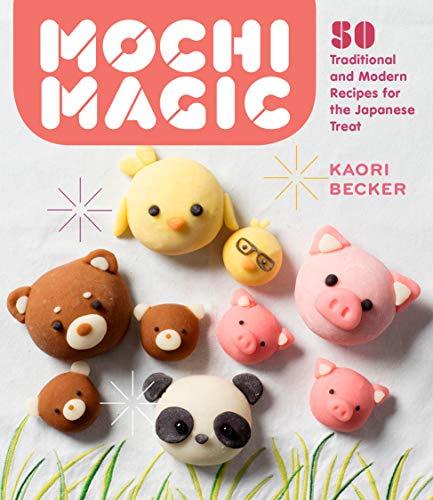
Kaori Becker’s Mochi Magic is an excellent, well-detailed, and beautiful recipe book. I love the range of easy-to-follow sweet and savoury recipes as well as the stunning full-coloured pictures. This book is so amazing that I bought the ebook before I even finished my review!
Mochi is a type of delicious sticky rice cake made from sweet Japanese short-grain rice. I love mochi and I had no idea it was so versatile. I learned a lot about Japanese culture in this book. The recipes are clearly written, easy-to-follow, and wonderfully detailed. They are accessible to all levels of cooks. Becker’s writing is simple and approachable. I like all the little stories and the great tips.
The book is divided into informative chapters on Mochi-Making Basics; Daifuku (Filled) Mochi: The Dough; Daifuku (Filled) Mochi: The Fillings; Decorating Mochi; A New Year’s Tradition: Pounded Mochi; Odango: Balls of Fun; and Baked Mochi. Becker introduces us to traditional mochi tools and ingredients like steamers and mallets as well as mochiko (the flour), matcha, and sweet bean pastes. We also learn about the various ways to make mochi: there’s hand-pounded, steamed, and the convenient microwave!
There are recipes for traditional treats like Matcha Mochi and Chocolate Mochi but there are also interesting dishes like Japanese Plum Wine Mochi and Rosewater Mochi. The book also includes many recipes for unique mochi fillings like Haupia Pudding, Black Sesame Cream Cheese Filling, and Earl Grey Truffle Filling. There are lots of recipes for dessert mochi but the book also includes savoury ones. There are traditional dishes like Ozoni Soup and Yaki Mochi with Sweet Soy Sauce but there’s also modern dishes like Bacon Wrapped Mochi! Mochi is so versatile that we can even make baked treats like Mochi Muffins, Coconut Chi Chi Dango, and Mochi Waffles.
The book’s design is bright and eye-catching. I love that it is brimming with pictures of everything! There are stunning full-colour full-page pictures for almost every single recipe. There are even pictures of the mochi making processes as well as the various ingredients like adzuki beans. Even the text is fun and colourful! I especially love the section on making cute animal mochi like bears and chicks as well as the adorable illustrations that pop up on several pages.
Mochi Magic is a wonderful, comprehensive, and gorgeous cookbook. I cannot wait to see what else Becker puts out!
Thank you to Storey Publishing and NetGalley for this book in exchange for an honest review.
🍡 🍡 🍡 🍡 🍡 odango out of 5!
#mochi magic#kaori becker#food#food recipes#NetGalley#cookbook#book review#mochi#books#book#book reviews#Japanese food
13 notes
·
View notes
Photo
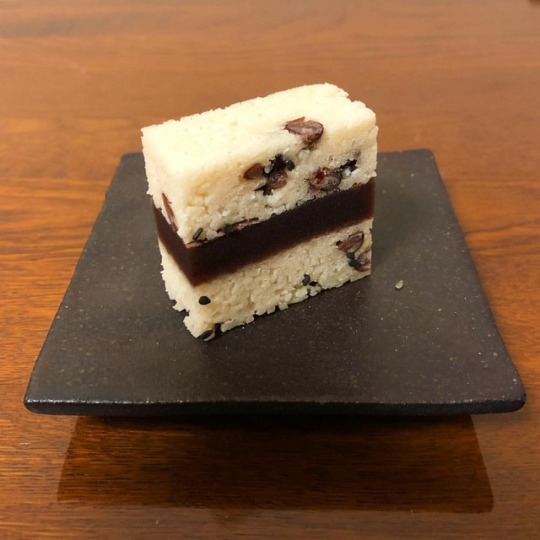
★ Feb. 10, 2018
Toraya, Tokyo: shirara-no-hama*1 (lit. Shirara Beach)
——–
The combination of a faded-black ‘konashi’? texture and two light yellow textures*2 containing sweet adzuki beans and black sesame seeds.
—-
Shirara-no-hama, one of Japan’s 100 Most Beautiful Beaches, has been known for its scenic, snowy white-sand sweep since ancient times. According to the shop, the cake named after the beach made its debut in 1707.
——–
*1 Located in a town called 'Shirahama (white beach)-cho (town)’ in Wakayama Prefecture.
*2 Made by straining, 'mincing', shaping and then steaming the mixture of sweet bean paste and rice flour, etc. The shop calls the recipe/process 'shippun-sei'.
——–
#wagashi #japanesesweets #sweets #tea #teaceremony #chanoyu #foodie #dessert #food #sweettooth #japan #japanese #matcha #tokyo #東京 #スイーツ #和スイーツ #お菓子作り #お茶の時間 #お菓子 #和菓子 #抹茶 #お茶 #茶道 #とらや #志良々の浜
#dessert#お茶の時間#お菓子作り#tokyo#和菓子#茶道#tea#japanese#foodie#東京#chanoyu#instasweets#foodpics#japanesesweets#teaceremony#スイーツ#instafood#抹茶#matcha#sweettooth#sweets#wagashi#お菓子#お茶#志良々の浜#japan#とらや#和スイーツ
53 notes
·
View notes
Note
So I saw the anman post with you muse, the two of you are hilarious! But now I must know as a fellow carb lover, what are anman buns? do things go inside them? are they a sweet bread? I just really want to know what makes an anman bun an anman bun ^^
Aww, thanks! Yeah, he’s adorbs when he isn’t being a buttmunch.
Anman are kind of an acquired taste, but I think they are so yummy. The mantou dough is super easy. I use 1/2tsp of active dry yeast, 1tsp of sugar (to feed the yeast. Not really needed, but I get better results with it), 1cup warm water (again, for the yeast), and then 3cups of all purpose flour. Then you just have to knead it forever (ok, more like 20 minutes, but when you have carpal tunnel it feels like forever) until it’s smooth, let it rise 30-60 minutes until it’s doubled in size and then you roll it out to make the buns. Then, you just steam them at medium heat for 12 mins, and then turn off the heat and let them set in the steamer for 5 minutes before pulling them out.
I personally like to fill mine with anko, or sweet red bean paste made from adzuki beans and some brown sugar, but you can fill them with a bunch of things and have dim sum. I have done pork and veggies that you would usually find in egg rolls and had them in a meal, and then I’ve done scrambled eggs, bacon, and over-cooked (so they were crunchy) hashbrowns and eaten them at breakfast. Anman itself though, is the mantou with anko inside. It’s considered a Japanese dessert. It’s not very very sweet, but it’s a mild sweetness. I love them because it touches my sweet tooth, but doesn’t overload it. I process carbs really well, so I love it when I’m watching my diet too. You can add more sugar to the bun and have it just as a sweet bread if you want, but I like it as is with fillings personally.
This is the recipe I use for my anman. https://www.youtube.com/watch?v=gEWrtGQ7qHk
She has a few recipes for the dough, but the measurements are all different across them, and the ones she has written in that video are the ones that work best for me. I just add the tsp of sugar on my own because my yeast reacts better that way and I am not a patient bread maker, so I want it to rise faster. I know you can do it with instant yeast, but I haven’t actually used that with anman before. I don’t use instant yeast all that often because I feel like my breads don’t come out as good when I use it.
(I feel like I should add the disclaimer that I am not Japanese, although I am pretty fly for a white...not-guy.... (That sounded more clever until I started typing it), and I am just coming into things with a Western understanding, so I am not the end-all authority on such things. This is just what I have learned since an exchange student friend in High School got me addicted to Japanese sweets and culture.)
5 notes
·
View notes
Photo

Sweet, sweet weekend filled with treats! Here’s the traditional #chendol from @OldAmoyChendol, new generation hawker preserving his grandfather’s original recipe with artisanal touches such as Japanese adzuki beans, cold-pressed coconut milk, patiently handmade green ‘worms’, and gula melaka specially sourced from Sarawak. The taste is pure and rich, without being overly sweet or cloying. They are also doing deliveries right now - WhatsApp your orders to 8748 7590. 🥰 . . . . . . #nothingisordinary #myfab5 #f52grams #dailyfoodfeed #lovefood #eatingfortheinsta #spoonfeed #huffposttaste #infatuation #buzzfeast #feedyoursoull #sgfood #tastingtable #forkyeah #eater #eattheworld #foodblogfeed #visitsingapore #thisissingapore #burpple #stayhomesg #sonysingapore #desserts #loveyourlocalsg (at Old Amoy Chendol) https://www.instagram.com/p/CAjf97RHzvm/?igshid=1bj8v4acsp0ja
#chendol#nothingisordinary#myfab5#f52grams#dailyfoodfeed#lovefood#eatingfortheinsta#spoonfeed#huffposttaste#infatuation#buzzfeast#feedyoursoull#sgfood#tastingtable#forkyeah#eater#eattheworld#foodblogfeed#visitsingapore#thisissingapore#burpple#stayhomesg#sonysingapore#desserts#loveyourlocalsg
0 notes
Text
You make miso happy

Miso soup, the quintessential Japanese dish. For the longest time, I had a tub of miso paste tucked neatly away in the corner of my fridge. I bought it at the height of my miso soup passion but it was now left neglected, with seemingly no other purpose in life. In an effort to find something else to do with it, I discovered that one of life’s greatest wonders lay hidden in the depths of my kitchen. My love affair with miso soup was on its last dregs, but my infatuation with miso paste had only just begun.
Miso paste is a fermented mixture of soy beans and a grain—rice or barley make a frequent appearance—inoculated with Koji, a type of mould. For the keen bean sake lovers: yes, the same Koji used to make the rice wine. This mixture is left to ferment with a healthy dose of salt, for a variable amount of time (more on that later). The mould breaks the beans down as it cultures, into a mixture of amino acids, fatty chains and simple sugars. The resulting concoction is deeply twangy, funky, an absolute umami bomb. And, as I hope I will be able to convince you by the end of this article, the secret ingredient that will bring you to unsurpassable culinary heights.
The colour, aroma, taste and pungency of a miso paste depends on a great number of factors. The conditions the paste is cultured in, for example, or the age of it. Even the geographical region in which it is let to culture plays a role – due to the different strains of bacteria available to lend a hand in the fermentation process
There is, it seems, a dizzying number of miso varieties, with over 1300 different types available, aged from anywhere between a few weeks to several years. But, in an effort to simplify the whole shebang (miso purists, please forgive my crude generalisation) they can be broadly broken down into two categories – sweet (sometimes called ‘light’) and dark miso pastes.
Sweet miso is the baby of the miso world. White miso paste (shiromiso) falls into this category. It is gloriously golden, the lightest of all the miso pastes – due to its higher percentage of grains. It has only had a several months-worth of fermentation, which is a heartbeat in the fermentation scene. The resulting taste is buttery, and mellow – and makes it, for beginners, the gateway drug. Or, for the adventurous, the best miso option in a sweet recipe.
Dark miso (sometimes called red miso, or akamiso), is the brooding older cousin, and more complex. Dark miso ranges in colour, from a dark brown to an almost-black. It has been fermented for a much longer time and contains more soybeans than it does grains. Time has made it deeply salty, earthy and robust. For this reason, it is the perfect ingredient to plop into a stew, or into a meat rub. It evokes memories of marmite, and indeed marmite is no stranger to a stew – providing the umami foundation upon which so much flavour is built.
If you avoid soy, fear not! There has been a recent influx of ‘new age’ miso. The hippies of the miso scene, if you will, and they can be made with anything from chickpeas, farro, adzuki beans, buckwheat, rye, millet, to… if the fermentation gurus of the internet are to be trusted… cookie dough. And while I lack the self-control to be in possession of spare cookie dough, I admire the passion for the cause.
Miso paste is a beautiful thing, not only because of its wonderful resonant taste, but also because of its versatility. Miso isn’t just for soup. Miso isn’t just for Japanese cuisine. You can use it in salad dressings, whisk it into marinades or brush it on as a glaze. Make a compound butter with it, and slather it onto thick wedges of toast. Use it in a sauce to bathe your noodles, mash it into silky potatoes. The line doesn’t end there. Desserts do equally well with a bit of the miso treatment. Swap out the salt in a salted caramel for a spoonful of this golden paste. You’re in for a treat.
As a fermented product, miso has a remarkable longevity, lasting almost indefinitely if treated with sufficient care. As a general rule of thumb, sweet miso is best if eaten within a year after opening – their fleeting fermentation period makes them a little less resilient than their darker counterparts. Dark miso, if left in sanitary conditions in the fridge, will practically last you forever. It will, however, darken over time, thanks to the powers of oxidation. But even this process can be hindered if you keep the surface of the paste covered neatly with a piece of baking parchment.
Another perk of being a fermented product: miso is jam-packed full of good bacteria. You know, the reason why yogurt is touted to be good for your gut? These bad boys are all over your miso paste. For this reason, if you are eating miso for its probiotic health benefit, you should avoid plunging it into a boiling stew or whacking it into the oven for a long braise. Instead, stir it into a stew right at the end, or brush it on as a glaze once most of the roasting is done. I admit to using the stuff, not for its ability to help my microbiome, but because it’s really, really tasty. So while I try not to overcook it, there will inevitably be situations where it cannot be avoided (in, say, baking a miso brownie). Taste trumps health benefit.
There is no better proof, than in the pudding, so I will supply you with what I have found is my favourite pudding to pair with miso. If there are any points awarded for a double pun whammy, I truly believe that this qualifies. I hope – no, I implore—you to give miso a second chance. It is not a one-hit wonder. In the words of Wild Cherry – Play that funky music.
Image Credit: Jules, Stone Soup
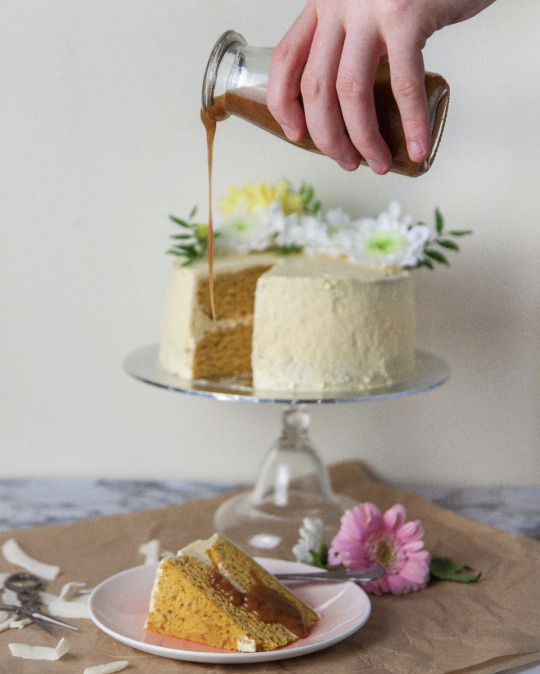
Miso Caramel Sauce
This is a vegan caramel sauce with which you should adorn every manner of desserts – ice cream, chocolate fondants, layer cakes or squidgy blondies. The only limit is your imagination, and – well – your stomach’s capacity. The 40 minutes of cooking time might seem exorbitant for a sauce but once it is in the pan it mostly takes care of itself, just give it a nudge every so often to prevent the bottom from catching on the pan
Ingredients
• 1 can full-fat coconut milk (1 ½ cups)
• ½ cup white sugar, or brown
• 3-4 tsp white miso (start with 3, then add more to taste)
• 1/2 tsp vanilla extract
In a heavy-bottomed saucepan, bring the coconut milk and sugar up to a simmer. Lower the heat to low and continue to cook, for about 40 minutes, until halved in volume. Stir it occasionally, perhaps every 10 minutes or so, to prevent it from catching and burning at the bottom of the pan. Once reduced to about ¾ cups, place a small amount of the hot milk mixture into a bowl with the miso paste and vanilla, and stir it to dissolve. Return this to the pan and stir to combine it fully. Remove it from the heat - the mixture will be an appealing light-golden colour, and will thicken up further as it cools. Store it in a clean jar, in the refrigerator, for up to a week.
Image Credit: Sasha Gill
0 notes
Text
White sesame & adzuki cheesecake

It has been 6 months since I started my new job. It’s not surprising that I’m busier than in my previous position, but I’ve found that I have much less time and energy than I expected on my days off. I was waiting for the fig season to come so I could make the Espresso, Fig & Raspberry Entremet with pink peppercorns (page 97) from the book Japanese Patisserie, but the best time for figs is now long gone and I’ve already seen frozen puddles in the streets. I have tried at least a couple of recipes from the book since I last posted. I just was not able to write about them. Finally today, I would like to talk about white sesame & adzuki bean cheesecake with tahini & chocolate sesame soil.
The base of the cheesecake was authentic, consisting of crumbled graham crackers pressed down to the bottom of a mold with melted butter. I prefer to use honey instead of butter for a lemony, refreshing yogurt cheesecake, but it was not difficult to imagine that this version would be creamy and rich, so I followed the recipe and used butter.

Many times, I have made non-baked cheesecake using cream cheese, whipped cream and gelatin. In these recipes, the whipped cream creates a light fluffy texture, but this time was the first recipe to use meringue for this purpose. Feeling a bit of pressure, I started making French meringue. It has to be hard and stable, otherwise a thick mixture of cream cheese, tahini and koshian paste would smash the form, and the cheesecake would be heavy, not fluffy. Other than this, the recipe was very easy, especially since I had previously made the chocolate sesame soil for a bitter chocolate, sesame and caramelized miso tart (here).
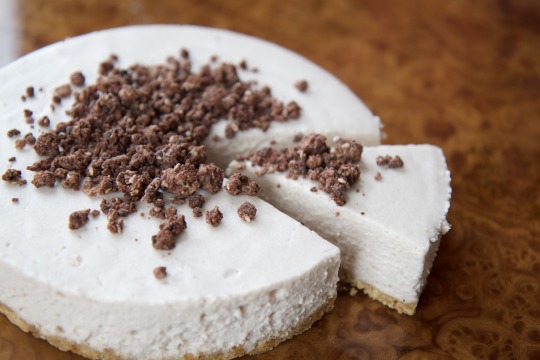
I made this for a dinner with friends. They also love food and cooking like my husband and me, and we often exchange cookbooks and ideas and invite each other over to test new recipes. Their cooking is always very inspiring and they are open to trying anything new, so I did not hesitate at all to bring this unique dessert. We all thoroughly enjoyed the combination of creaminess from the cream cheese and the cream fraiche, bitterness from the tahini, and the subtle koshian flavor. I honestly expected the cake to have a somewhat stronger flavor of adzuki, and I am sure it would not be exotic even with a bit more koshian flavor. Maybe next time, I will test a little less tahini and more koshian. Overall, this is a gorgeous, rich, and risk-free dessert recipe for a dinner and/or a party. I am sure everyone will enjoy this unique cheesecake.
1 note
·
View note
Text
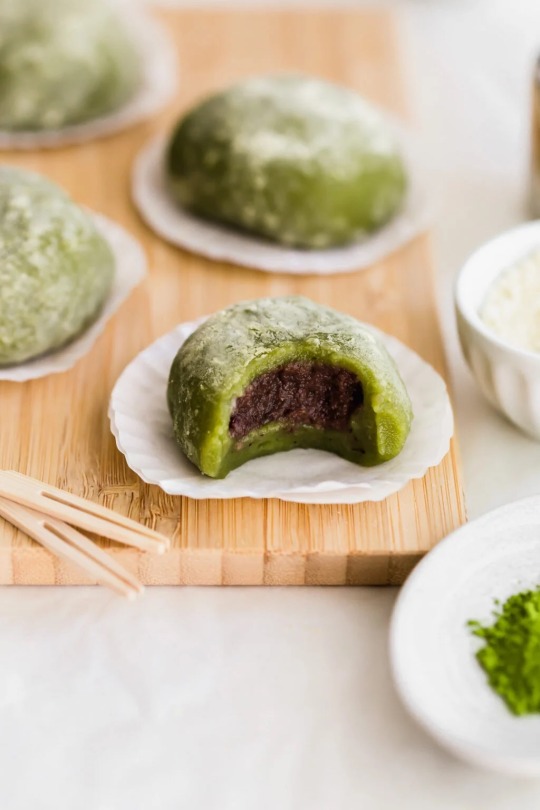
Matcha Red Bean Mochi
#matcha#red bean#adzuki#mochi#glutinous rice#recipe#tea#green tea#color#tea time#dessert#stuffed#asian#japanese#chinese#kinakko#siftandsimmer
189 notes
·
View notes
Text
New Post has been published on Toronto Events, Activities and Entertainment
New Post has been published on https://www.torontonicity.com/recipe/turkey-chili-with-adzuki-beans/
Turkey Chili with Adzuki Beans: Recipe
Thanksgiving has come and gone and you probably have turkey leftovers in your fridge or freezer. As delicious as roasted turkey tastes on Thanksgiving, it can lose its lustre once you’ve had the same meal for several days running. You definitely don’t want to throw out your leftover turkey since there are many creative ways to add turkey to other dishes. Turkey Chili with Adzuki Beans is an easy way to use those turkey leftovers up while presenting a new recipe that won’t bore the palates of your family.
Turkey Chili with Adzuki Beans
I’ve chosen adzuki beans for this recipe because I follow the “Eat Right For Your Blood Type” diet and for my blood type O, adzuki beans are the only beans that are beneficial for my health. If your family doesn’t enjoy larger beans such as kidney, navy or lima beans, they may enjoy adzuki beans because they are much smaller and easier to digest. They also have a nutty and sweet taste. In fact, the Japanese use adzuki beans to make a sweet dessert paste.
If you want to save some time, you can use canned adzuki beans in this recipe and avoid having to soak the dried beans overnight. The canned adzuki beans taste just as good as the dried adzuki beans.
Please let me know in the comment section if you make Turkey Chili with Adzuki Beans.
0 notes
Text
Back with another recap once again, baby! It’s only the third day, and I pretty much was spoiled with more food in one sitting than I used to eat in a week prior to my vegan days. My stomach already feels like bursting just looking at all of the photos!
Processed with VSCO with f2 preset
Processed with VSCO with f2 preset
The first part of my breakfast comprised of classically plain corn flakes with some ripe apple bananas and unsweetened soy milk! I was worried that I’d be bored with the bland flavors, but the sweetness from the banana and the crunchiness from the corn flakes harmonized together beautifully! Of course, I enjoyed drinking all of the soy milk afterwards. It tasted like banana milk with a few crushed corn flake pieces! Honestly, who on Earth would skip drinking milk that’s just been soaked in cereal?

Couple minutes later, I was surprised with baked purple sweet potatoes, Japanese sweet potatoes, and chè with black-eyed peas (may or may not have said mung beans in the video!)! In Vietnamese, this beverage-like dessert is pronounced chè đậu trắng, and it is made with coconut milk, water, sugar, and broken rice! There are other variations that use sesame seeds, adzuki beans, black beans, potato, agar agar, jelly, mango, durian, bananas, and more! Before, I never liked the taste of these desserts, but this chè was oh-so-delicious! I think I just needed to try a truly authentic creation of it. Oh yeah, and you bet I smothered all of it and more atop my bowl of purple and Japanese sweet potatoes with corn flakes! I was absolutely stuffed afterwards, but it was worth it!
To tell the truth, I only did a little window shopping at a clothing market that was very similar to Ben Thanh, as well as my uncle’s jewelry store. I didn’t see anything that special aside from a uniquely adorable shirt that I bought, so I didn’t take any pictures of scenery and such today. However, you can still take a look at my video to find out what went on then!

At the jewelry store, I met my younger cousin Anna for the first time and practically fell in love with her at first sight! She was pretty shy, but everyone showered her with so much attention that my youngest sister could relate to what it’s like having a younger sibling. I totally lost track of how many times I tried to get Anna to say my name and give me a high-five. Never successful for either of them. Not even once.
Do you see a resemblance?
Processed with VSCO with f2 preset
Processed with VSCO with f2 preset
Processed with VSCO with f2 preset
Processed with VSCO with f2 preset
Lunchtime eats called for something incredibly special. Not for any particular occasion, but a few of us were craving banh xeo. Hence, our wishes were granted once we arrived back at my grandmother’s home! I myself feasted on not one, not two, but FIVE banh xeo crepes that were stuffed with mushrooms, tofu, and onions along with a head’s worth of lettuce!

Seconds after believing I was done, there’d be another banh xeo right in front of me to eat. At first, I was extremely nervous about eating the banh xeo pancakes because I wasn’t sure if they were made with eggs, but we got the OK after the nanny disclosed the recipe: rice flour, coconut milk, and turmeric! Woohoo! My shorts felt like they were going to explode after I finished eating. The food coma kicked in so quickly that I passed out in my room a minute later!
Hour and a half passes by, and we decide to play a board game that involves racing horses. Because of the rules, the game turned out to be such a pain in the neck that it initiated a lot of competition between me, my cousins, and my sisters.
Objective: complete the entire race on the board four times (each player is given four horse figures); the first to finish the race wins.
Roll two dice.
If you land on snake eyes, you lose all of your horse figures and have to start the race over again.
If you land on the same sides, you have to roll again until both dice land on different numbers or you land on snake eyes. (both are threes or both land on six). If you land on doubles by the third try, you have to skip your next turn.
Two horses aren’t allowed to land on the same spot. The player that arrives to the spot next kicks the other player out.
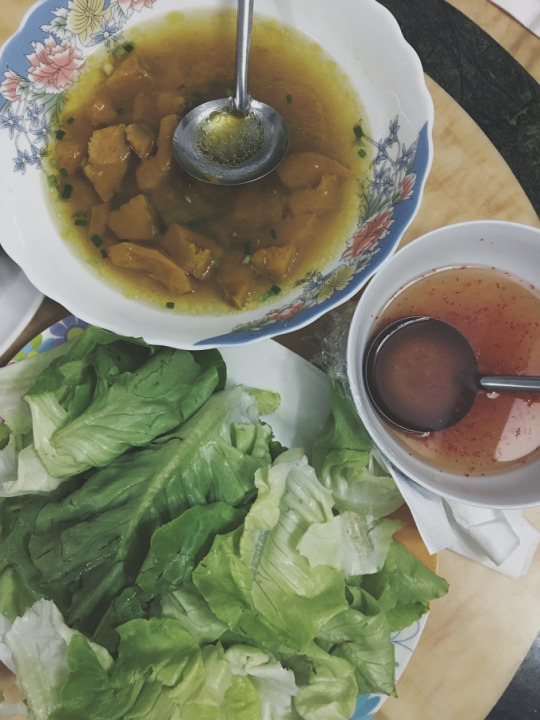
For dinner, the family enjoyed some warming soup to calm our stomachs after a wildly special lunch! The housekeepers prepared me an incredibly simple but wonderful kabocha squash soup with some onions and spices! I ate around half of the soup in the entire serving bowl, even though I was still pretty full from the crepes. When in Vietnam, you eat like a queen when food is personally homemade.
Anyways, the rest of the night was spent in the citywalk, enjoying the life in the night.

Our car dropped us off right around the building of the People’s Committee and the famous statue of Ho Chi Minh!

Seeing these famous monuments sparked me to reflect on the political turmoil and the absolute chaos ensued by a single rebellion. It made me wonder how the experiences of oppression from an overpowering government that practiced so much violence towards its people would truly feel. I immediately felt sad for my parents and my relatives, but so grateful that they now lead prosperously loving and happy lives today.

Debate regarding political systems is inevitable, but treatment towards the people is what everything boils down to. So as long as citizens are satisfied with their freedoms and their privileges, then the country is indeed at a healthy state. Of course, Vietnam has modernized drastically from its Communist government, hence living here is much more pleasant than it would be decades ago.
Do you drink milk after it’s been soaked in cereal? What are your favorite historical monuments?
Day 3 in Vietnam: Cute Cousin + Vegan Food (LOTS of It) Back with another recap once again, baby! It's only the third day, and I pretty much was spoiled with more food in one sitting than I used to eat in a week prior to my vegan days.
#adorable#advice#agar agar#animals#art#Asia#Asian#asian cuisine#authentic#balance#banana#bananas#banh xeo#beans#beauty#beverage#binge#binge eating#binge eating disorder#black beans#black-eyed peas#blend#blog#blogger#bloggers#blogging#body#breakfast#buckwheat#Buddha
0 notes
Photo
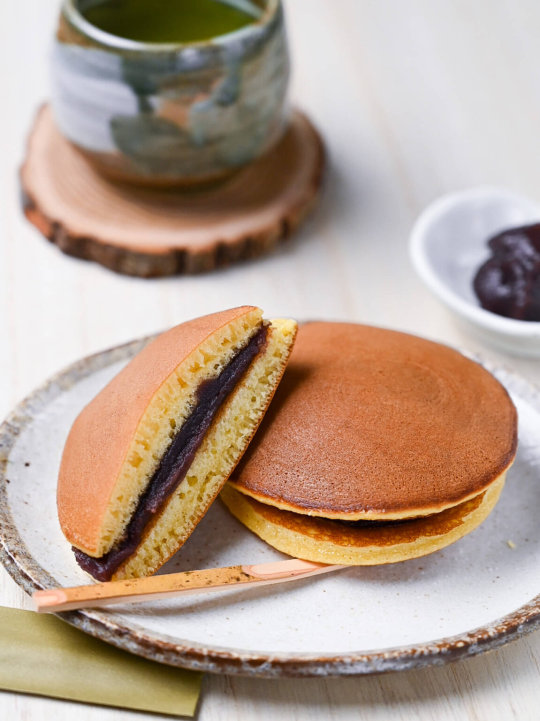
Dorayaki
#dorayaki#japanese#pancakes#food#dessert#snack#baking#kids#recipe#red bean#asian#adzuki#sudachirecipes
264 notes
·
View notes
Photo

Taiyaki(たいやき)
316 notes
·
View notes
Photo

Strawberry Red Bean Mochi
#strawberry#red bean#mochi#adzuki#glutinous rice#rice#food#dessert#japanese#asian#berries#fruit#recipe#siftandsimmer
213 notes
·
View notes
